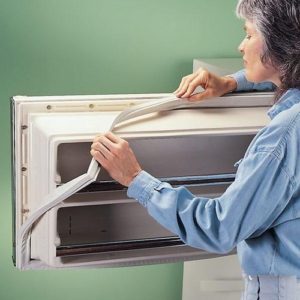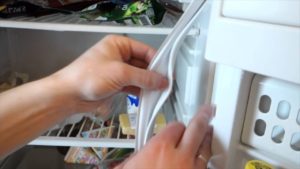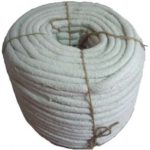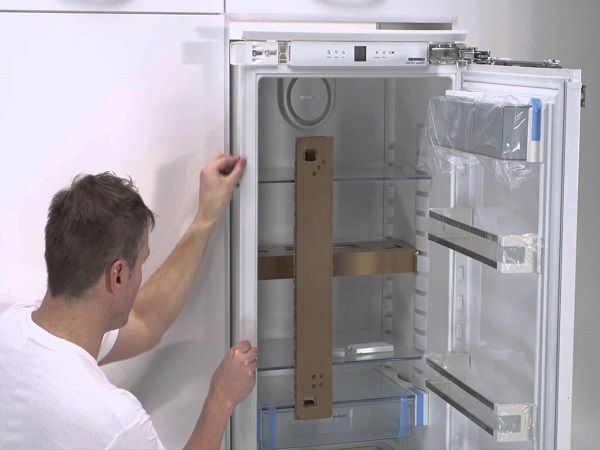How to change the rubber seal on a refrigerator
 To understand the role the seal plays in a refrigerator, you need to have an idea of its design features. The task of individual components of refrigeration equipment is to ensure proper heat removal from the products placed inside it. If warm air from outside constantly enters the storage chambers, then all the work of the system elements will not bring the desired results, and cooling will be leveled out.
To understand the role the seal plays in a refrigerator, you need to have an idea of its design features. The task of individual components of refrigeration equipment is to ensure proper heat removal from the products placed inside it. If warm air from outside constantly enters the storage chambers, then all the work of the system elements will not bring the desired results, and cooling will be leveled out.
It is for these reasons that a seal is installed on the door to prevent the entry of outside air. At the same time, the material itself can be different, the main thing is that it must meet quality requirements. Otherwise, ice will constantly freeze inside the equipment, snow will accumulate, the compressor will work in increased mode and sooner or later it will completely fail.
The loose fit of the insulating element creates gaps that are sometimes visible even to the naked eye. You can check their presence using a sheet of paper. Its free movement in the crack will be a clear indication of a problem in the insulating unit of the refrigerator. This problem can arise for two reasons: due to wear and damage to the rubber (in the case of older models) or due to the fact that the door position is not adjusted. In the second case, no replacements are required; you just need to adjust the door correctly. In the first case, you will have to select a new seal and replace the damaged one.
The content of the article
Which rubber band is better to choose for replacement?
Reference! There are several types of seals that are mounted in the refrigerator using screws, glue, screws or inserted into a groove designed for this purpose. They have different shapes and are made of different materials.
 On the market you can find products with one or two cylinders. As a rule, a magnet is located in the second cylinder to ensure a tight fit of the door to the refrigerator body. There are also older versions made of rubber on sale. Modern seals are made of polyvinyl chloride. There are several ways to attach it: either placing it in a special recess (groove), or fixing it using glue or screws.
On the market you can find products with one or two cylinders. As a rule, a magnet is located in the second cylinder to ensure a tight fit of the door to the refrigerator body. There are also older versions made of rubber on sale. Modern seals are made of polyvinyl chloride. There are several ways to attach it: either placing it in a special recess (groove), or fixing it using glue or screws.
The first method makes it easy to install and remove while washing the refrigerator, the second carries risks of damage and creates difficulties during repeated replacement (if glue is used).
Any refrigerator model has its own requirements for the design of the insulation unit. If the new sealing element is not selected correctly, the protection will not be provided at the required level. In addition, pressure from a closed door, coming at an incorrect angle and having different strengths, leads to deformation and subsequent cracking of the product. It is worth remembering that no matter what the seal is, as it is used it loses its elasticity.
Step-by-step instructions for replacing the seal
First. First you need to turn off the power to the refrigerator. If the door is small, it can be left in place. If the sash is impressive, it is better to dismantle it and place it on a horizontal surface.
 Second. In several places, the junction of the old seal and the door is carefully trimmed, after which, by slightly pulling the rubber band away from the landing site and sliding a spatula, it is removed along the entire perimeter of the sash. The work must be carried out carefully, trying not to leave scratches on the door material.
Second. In several places, the junction of the old seal and the door is carefully trimmed, after which, by slightly pulling the rubber band away from the landing site and sliding a spatula, it is removed along the entire perimeter of the sash. The work must be carried out carefully, trying not to leave scratches on the door material.
Third. It is easier to select a replacement seal when we are talking about the Indesit and Ariston brands. The edge of the product is quite rigid and does not require any modification. In the case of Atlant and Stinol refrigerators, it is more difficult to find a suitable elastic band, so the most suitable option is finalized - the thickening is cut off with a knife.
Fourth. If there are any glue particles left in the groove, they must be removed. The space for the new seal must be clean, otherwise there is a high risk of insulation failure.
 Fifth. The new sealing element is located around the perimeter of the door. When planting with glue, it is better to use “Moment”. In accordance with the instructions, the glue is applied to the surface and allowed to stand for some time. After which the elastic band is gradually glued to the sash. If screws are used, then fixation is carried out first in the corners, then in increments of 10–15 cm along the entire contour.
Fifth. The new sealing element is located around the perimeter of the door. When planting with glue, it is better to use “Moment”. In accordance with the instructions, the glue is applied to the surface and allowed to stand for some time. After which the elastic band is gradually glued to the sash. If screws are used, then fixation is carried out first in the corners, then in increments of 10–15 cm along the entire contour.
Sixth. To improve the quality of the connection, the elastic band is heated with a hairdryer for several minutes. The temperature regime is set to 300 °C.
Seventh. It is easy to check the quality of the work performed - the door should open with some effort. Over time, it will become clear whether reliable insulation is provided. If ice stops rapidly forming in the refrigerator, then everything was done correctly.





